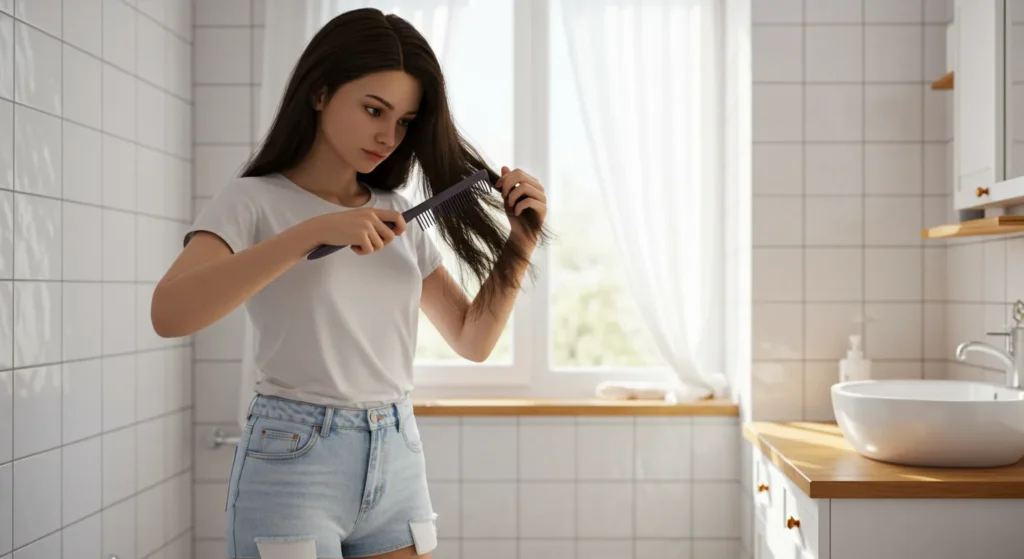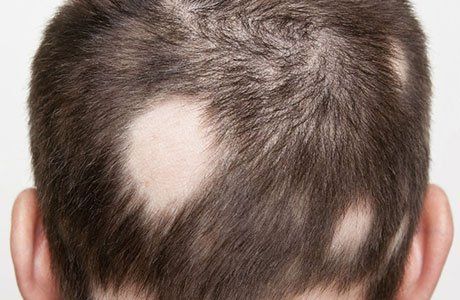Hair thinning at 16 can feel overwhelming, especially when it’s unexpected. Whether it’s sudden hair shedding, a receding hairline, or visible scalp patches, thinning hair in teens is more common than many realize.
In this article, we explain the causes of hair thinning at 16, how to treat it effectively, and when to seek expert advice. Backed by medical insight and practical tips, this guide will help you regain control and support healthy hair growth.
What Does Hair Thinning at 16 Look Like?
Hair thinning during the teenage years often presents subtly at first but can quickly become noticeable. It’s important to differentiate it from normal hair shedding.

Typical Signs & Symptoms in Teens
- Increased hair strands on your pillow or in the shower
- A wider part line or visible scalp areas
- Less volume or density overall
- Thinner ponytails or slower hair growth
Patterns vs. Diffuse Thinning
- Patterned thinning usually affects the temples or crown and may indicate genetic hair loss.
- Diffuse thinning happens evenly across the scalp, commonly seen in stress-related or nutritional causes.
When Thinning at 16 Is More Than Just Shedding
Losing 50–100 hairs per day is normal. However, persistent shedding, hair breakage, and bald spots may point to underlying health or hormonal issues.
Common Causes Behind Teenage Hair Thinning
Understanding why your hair is thinning is the first step to addressing it properly. Here are the most common causes:
Early-Onset Androgenetic Alopecia
Genetic hair loss, or male/female pattern baldness, can begin as early as the mid-teens in genetically predisposed individuals. You may notice gradual thinning at the hairline or crown.
Telogen Effluvium (Stress-Induced Shedding)
Emotional stress, exams, or a major life change can push hair follicles into a “resting” phase. Shedding typically begins 2–3 months after the stressor.
Nutritional Deficiencies
Low levels of iron, zinc, vitamin D, or biotin can severely impact hair health.
- Teenagers on restrictive diets or with eating disorders are especially at risk.
- A blood test can identify deficiencies.
[Medical Reviewer Note Needed Here]
Hormonal Changes (Puberty, PCOS, Thyroid Disorders)
Hormonal imbalance, especially in females, can lead to hair thinning:
- PCOS is associated with increased androgens, which can shrink hair follicles.
- Thyroid dysfunction affects hair’s growth cycle and may cause diffuse thinning.
Autoimmune Conditions (Alopecia Areata)
If you notice small, round bald patches, alopecia areata might be the cause. It’s an autoimmune disease where your body attacks hair follicles.
Traction Alopecia & Styling Damage
Tight hairstyles, frequent braiding, or harsh chemical treatments can physically damage follicles, leading to localized thinning.

Other Medical Causes
- Fungal scalp infections (e.g., tinea capitis)
- Side effects from medications (e.g., acne treatments, antidepressants)
How Common Is It & Why It’s Not Just “Normal Teen Stuff”
Though often dismissed, teenage hair thinning is surprisingly prevalent. Research suggests that 15–30% of teens may experience some form of hair loss.
Psychological & Emotional Impact
Hair thinning can affect:
- Self-esteem and social confidence
- Mental health, contributing to anxiety and body image issues
Unlike routine shedding, ongoing thinning shouldn’t be ignored, especially when it disrupts daily life or emotional well-being.
Diagnosing Hair Thinning at 16
When to See a Specialist
If hair loss persists for over 3 months, or you notice balding patches, it’s time to consult:
- A dermatologist
- A trichologist (hair and scalp specialist)
Key Diagnostic Tools
- Trichoscopy: A scalp microscope helps assess follicle health.
- Blood Tests: Check for anemia, thyroid function, and vitamin levels.
- Scalp Biopsy: Rarely needed, but may confirm autoimmune causes.
Expert Tip:
Treatment & Management Strategies
Medical Treatments
- Topical Minoxidil (2–5%): FDA-approved, often safe for teens with early androgenetic alopecia. Always consult a doctor first.
- Low-Level Laser Therapy (LLLT): A non-invasive option to stimulate growth.
- Corticosteroid Injections: For alopecia areata cases.
Nutritional & Lifestyle Adjustments
- Eat a balanced diet rich in iron, protein, zinc, and B vitamins.
- Get 8 hours of sleep, reduce stress, and exercise regularly.
- Stay hydrated and avoid fad diets.

Protective Haircare Habits
- Avoid tight ponytails, braids, or extensions.
- Limit heat tools like straighteners.
Tracking Progress: Recovery Timelines
| Condition | Recovery Period |
|---|---|
| Telogen Effluvium | 3–6 months |
| Nutritional Hair Loss | 2–4 months post-supplementation |
| Minoxidil Response | Starts at 4 months; visible at 6+ months |
FAQs on Hair Thinning at 16
Is hair thinning at 16 normal?
Not necessarily. While temporary shedding can happen, consistent thinning needs attention.
Will my hair grow back?
In many cases, yes—especially if it’s stress-related or due to a deficiency.
Can hair products cause permanent damage?
Overuse of heat and chemicals can damage follicles. Switch to gentle, teen-safe options.
Is minoxidil safe for teens?
It can be, under medical supervision. Never self-prescribe.
How long will it take to see improvement?
Typically 3–6 months, depending on the cause and treatment adherence.
When to Consider Further Intervention
If treatments don’t work after 6–12 months or thinning worsens, further steps may include:
- Hormone evaluations
- Scalp PRP therapy
- Early-stage hair restoration planning (not typically recommended under 18 unless necessary)
Regain Your Confidence Now
Concerned about hair thinning at 16?
Book a confidential consultation with Dr. Rana Irfan, ABHRS-certified hair restoration expert in Islamabad.
We offer early diagnostics, personalized care, and teen-friendly treatment plans to help you regain your confidence.
👉 Book Your Consultation Now
